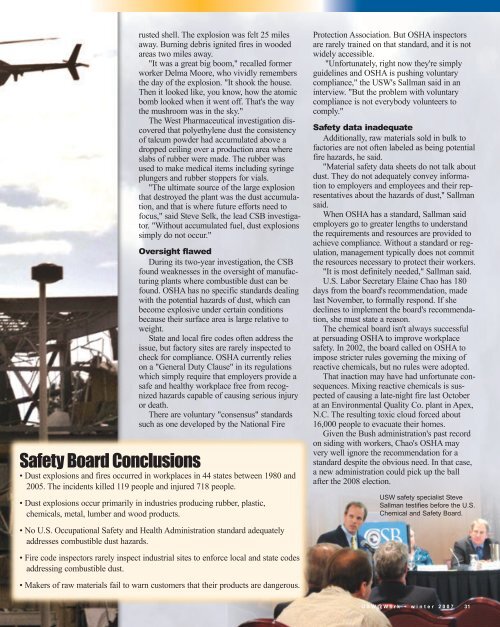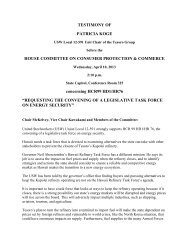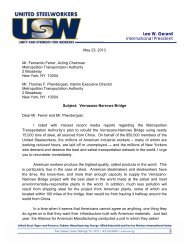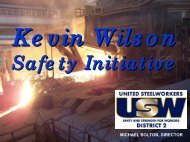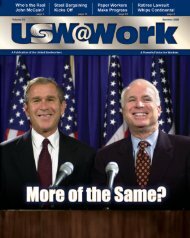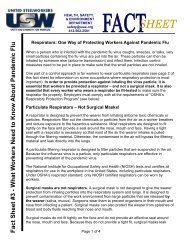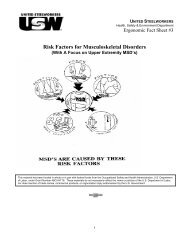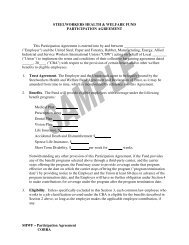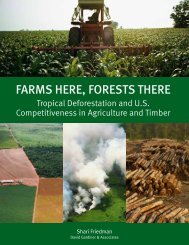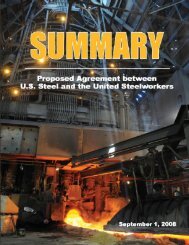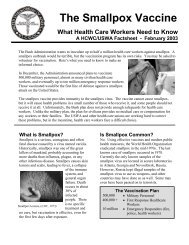USW@Work - National College Players Association - United ...
USW@Work - National College Players Association - United ...
USW@Work - National College Players Association - United ...
- No tags were found...
You also want an ePaper? Increase the reach of your titles
YUMPU automatically turns print PDFs into web optimized ePapers that Google loves.
usted shell. The explosion was felt 25 milesaway. Burning debris ignited fires in woodedareas two miles away."It was a great big boom," recalled formerworker Delma Moore, who vividly remembersthe day of the explosion. "It shook the house.Then it looked like, you know, how the atomicbomb looked when it went off. That's the waythe mushroom was in the sky."The West Pharmaceutical investigation discoveredthat polyethylene dust the consistencyof talcum powder had accumulated above adropped ceiling over a production area whereslabs of rubber were made. The rubber wasused to make medical items including syringeplungers and rubber stoppers for vials."The ultimate source of the large explosionthat destroyed the plant was the dust accumulation,and that is where future efforts need tofocus," said Steve Selk, the lead CSB investigator."Without accumulated fuel, dust explosionssimply do not occur."Oversight flawedDuring its two-year investigation, the CSBfound weaknesses in the oversight of manufacturingplants where combustible dust can befound. OSHA has no specific standards dealingwith the potential hazards of dust, which canbecome explosive under certain conditionsbecause their surface area is large relative toweight.State and local fire codes often address theissue, but factory sites are rarely inspected tocheck for compliance. OSHA currently relieson a "General Duty Clause" in its regulationswhich simply require that employers provide asafe and healthy workplace free from recognizedhazards capable of causing serious injuryor death.There are voluntary "consensus" standardssuch as one developed by the <strong>National</strong> FireSafety Board Conclusions• Dust explosions and fires occurred in workplaces in 44 states between 1980 and2005. The incidents killed 119 people and injured 718 people.• Dust explosions occur primarily in industries producing rubber, plastic,chemicals, metal, lumber and wood products.• No U.S. Occupational Safety and Health Administration standard adequatelyaddresses combustible dust hazards.• Fire code inspectors rarely inspect industrial sites to enforce local and state codesaddressing combustible dust.• Makers of raw materials fail to warn customers that their products are dangerous.Protection <strong>Association</strong>. But OSHA inspectorsare rarely trained on that standard, and it is notwidely accessible."Unfortunately, right now they're simplyguidelines and OSHA is pushing voluntarycompliance," the USW's Sallman said in aninterview. "But the problem with voluntarycompliance is not everybody volunteers tocomply."Safety data inadequateAdditionally, raw materials sold in bulk tofactories are not often labeled as being potentialfire hazards, he said."Material safety data sheets do not talk aboutdust. They do not adequately convey informationto employers and employees and their representativesabout the hazards of dust,'' Sallmansaid.When OSHA has a standard, Sallman saidemployers go to greater lengths to understandthe requirements and resources are provided toachieve compliance. Without a standard or regulation,management typically does not committhe resources necessary to protect their workers."It is most definitely needed," Sallman said.U.S. Labor Secretary Elaine Chao has 180days from the board's recommendation, madelast November, to formally respond. If shedeclines to implement the board's recommendation,she must state a reason.The chemical board isn't always successfulat persuading OSHA to improve workplacesafety. In 2002, the board called on OSHA toimpose stricter rules governing the mixing ofreactive chemicals, but no rules were adopted.That inaction may have had unfortunate consequences.Mixing reactive chemicals is suspectedof causing a late-night fire last Octoberat an Environmental Quality Co. plant in Apex,N.C. The resulting toxic cloud forced about16,000 people to evacuate their homes.Given the Bush administration's past recordon siding with workers, Chao's OSHA mayvery well ignore the recommendation for astandard despite the obvious need. In that case,a new administration could pick up the ballafter the 2008 election.USW safety specialist SteveSallman testifies before the U.S.Chemical and Safety Board.<strong>USW@Work</strong> • winter 2007 31


